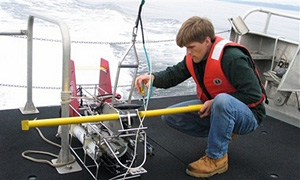 |
 |
 |
 Editorials | Environmental | August 2006 Editorials | Environmental | August 2006  
Pacific "Dead Zone" Worse Than Thought
 Associated Press Associated Press


| | Oregon State University graduate student Anthony Kirincich prepares to launch a monitoring device off the deck of the research vessel, Elakha, Aug. 10, 2004, towed to gather data about the return of a 'dead zone' off the central Oregon Coast. (AP/Jeff Barnard) |
Portland, Ore. - The oxygen-starved "dead zone" along the Pacific Coast that is causing massive crab and fish die-offs is worse than initially thought, scientists said.

Weather, not pollution, appears to be the culprit, scientists said, and no relief is in sight. However, some said there is no immediate sign of long-term damage to the crab fishery in the dead zone, a 70-mile stretch of water along the Continental Shelf between Florence and Lincoln City.

Oregon State University scientists looking for weather changes that could reverse the situation aren't finding them. They say levels of dissolved oxygen critical to marine life are the lowest since the first dead zone was identified in 2002. It has returned every year.

Strong upwelling winds pushed a low-oxygen pool of deep water toward shore, suffocating marine life, said Jane Lubchenco, a professor of marine biology at OSU.

She said wind changes could help push that water farther out, but current forecasts predict the opposite.

After a recent trip to the dead zone and an inspection via camera on a remote-controlled submarine, she said, "We saw a crab graveyard and no fish the entire day."

"Thousands and thousands of dead crab and molts were littering the ocean floor. Many sea stars were dead, and the fish have either left the area or have died and been washed away."

The effect on the commercial fishery isn't yet known, said Hal Weeks, a marine ecologist with the Oregon Department of Fish and Wildlife. He said the last two years were record-breaking for the Dungeness crab despite dead zones.

"In that fishery, there has been no apparent effect," he said. "That doesn't mean there won't be."

Weeks said crab populations fluctuate wildly for reasons not well understood. Whether any harvest decline is a result of normal fluctuation or the effects of the dead zone is hard to say, he said.

He said some reports indicate the loss of fin fish may be due to their movement to areas with more oxygen rather than to mortality.

Al Pazar, chairman of the Oregon Dungeness Crab Commission and a crab fisherman, said this season is shaping up to be the second-best ever, around 28 million pounds, but that most crabs are caught in the six or eight weeks following the season's winter opening, well ahead of the appearance of the dead zones.

Few boats are fishing now, he said, and the season closes at midnight Monday. But he said the affected area is a major crab producer, "right in the thick of it."

The 2002 dead zone was the worst until this year's, he said. After 2002, he returned to the area when the season reopened and had good results.

"They do move back in," he said.

Oregon State scientists working with the Oregon Department of Fish and Wildlife used a remote-control device Aug. 8 to check biological impact and continue oxygen sampling.

Dissolved oxygen readings off of Cape Perpetua north of Florence are between 3 percent and 10 percent of levels needed for survival and near zero in some areas.

A reef near Yachats normally swarms with rockfish, but they are gone. Dead Dungeness crab, sea stars and other marine life carpet the ocean floor.

Similar but lesser zones have been found elsewhere along the Oregon and Washington coasts. Scientists say they don't yet know how widespread it is.

Some dead zones been caused by agricultural runoff. Those similar to Oregon's have been found off Africa in the Atlantic and Peru in the Pacific. | 
 | |
 |



